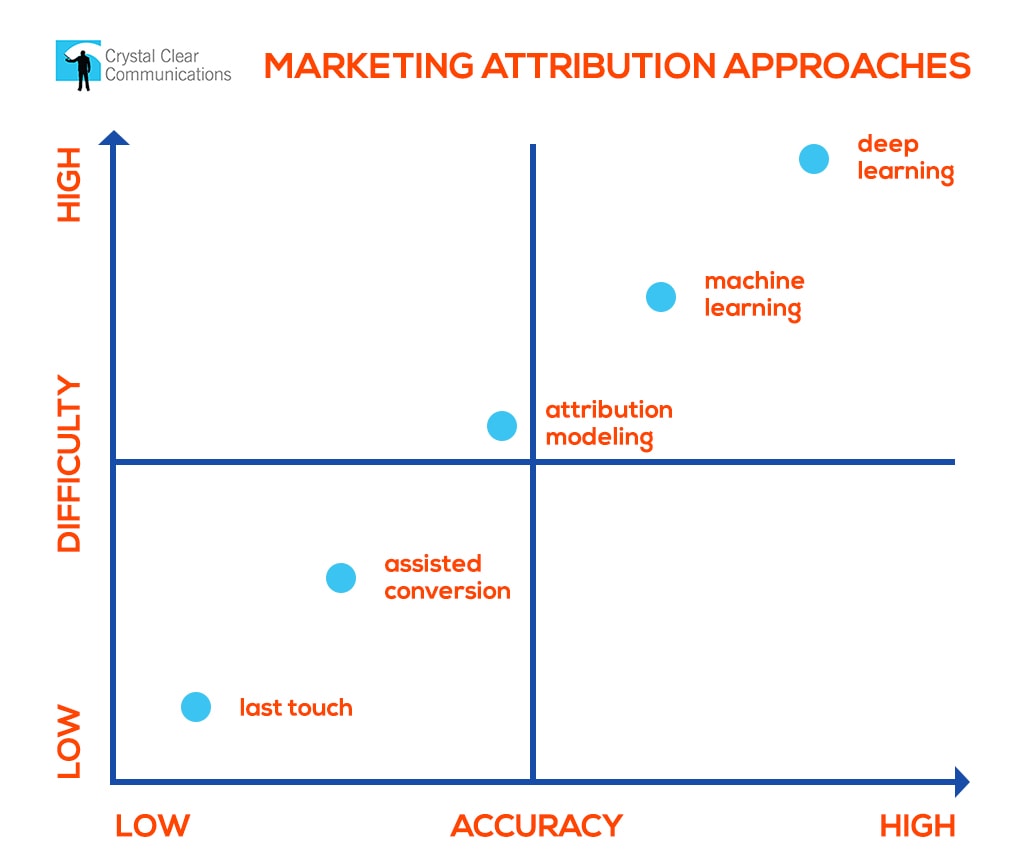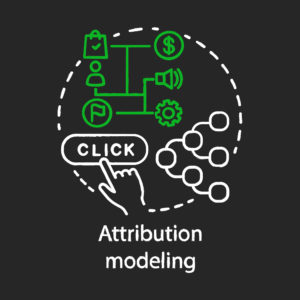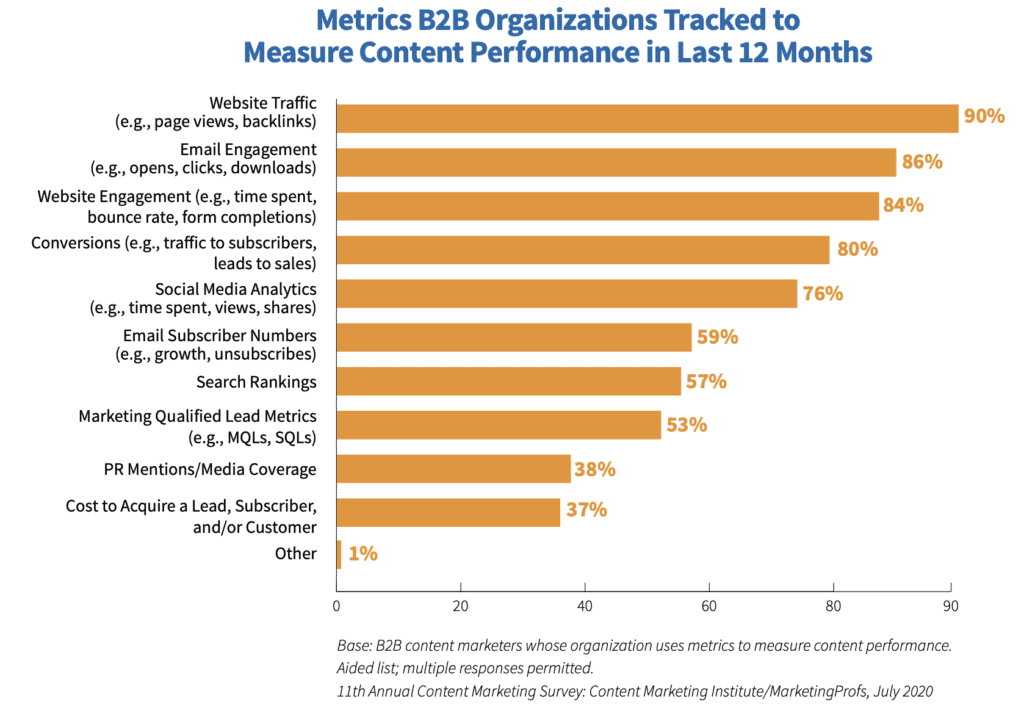
“How do you separate the effectiveness of content marketing from the effects of other confounding variables?”
A marketer from C Spire asked this question, one of the Top 100 Questions on content marketing.
For marketers, attribution is a measurement puzzle to solve. In fact, in our research on the Top 100 Questions, consumer marketers identify attribution as the #1 challenge they face.
What is marketing attribution?
Marketing attribution is all about using analytic science to figure out which marketing strategies and tactics lead to conversions and sales. Attribution is “just proving what happened,” says marketing artificial intelligence (AI) guru Christopher S. Penn.

Proper attribution enables you to invest wisely in activities today that will drive sales tomorrow. Good attribution enables marketers to place more and more winning bets to increase their company’s return on marketing investment (ROMI).
How well do marketers connect content marketing with ROI?
Almost 3 out of 5 of consumer (B2C) marketers measure return on investment (ROI), a Content Marketing Institute survey found.
About half of business (B2B) marketers say their organizations measure content marketing ROI. Among the most successful B2B marketers, about 3 out of 4 measure content marketing ROI.
Some 4 out of 5 B2B marketers use metrics to measure content performance, while 3 out of 4 consumer marketers use metrics on content performance.

Which measures do marketers use most?
Specifically, more than half of B2B marketers measure website traffic and engagement, email engagement and subscribers, conversions, social media, search rankings, and marketing qualified leads. About a third measure subscriber or customer acquisition costs, metrics which are required to derive ROMI:

More than 3 out of 4 consumer marketers use metrics, CMI found.
Compared with B2B marketers, consumer marketers place more emphasis on social media measurement. About 2 out of 5 track lead, subscriber, or customer acquisition costs:

Attribution parses out the exact contribution from content
It’s a thorny problem: How to sort out the contribution of content marketing from all other marketing activities to prove results from content? To attribute results accurately challenges even the best marketers.
In fact, the attribution problem extends well beyond content marketing to all forms of marketing. Businesses need to know what happened with their marketing investments, what results were achieved, and how much each marketing activity contributed to revenue or profits.

Which type of attribution you need depends on what exactly you’re trying to prove.
3 places to prove that content marketing works on its own
If your boss is breathing down your neck, saying you need to prove content marketing works on its own, take a purist approach. Here’s how.
Create a space where content marketing can have enough space and time (12 to 24 months) to work all on its own. Draw boundaries around a definable market, to assure that no other marketing activities take place in that space.
Three promising places to start and prove in content marketing are short-cycle sales, orphans, and greenfields.
1. Short-cycle sale
A short-cycle sale is the type of sale where customers make decisions faster, so revenue comes in quicker. That’s why it’s a great place to start – results will become evident faster.
In the telecom network equipment market, buyers may take 12 to 30 months to reach buying decisions. On the other hand, electric utilities can reach decisions in 3 to 6 months.
That’s why Tellabs launched a content marketing pilot project with electric utilities instead of telecom customers. Shorter buying cycles enabled us to demonstrate the effectiveness of content marketing much sooner.
2. Orphan market
An orphan is a product or a market that has gotten zero marketing support in the past year. While it has growth potential, it’s suffered from neglect.
Most big companies have multiple orphan products or lines of products that make perfect laboratories for content marketing experiments.
Adopt an orphan by providing content marketing support only. When the orphan’s sales rise unexpectedly, others will start to clamor for content marketing to support their products. That’s when people jump on the content marketing bandwagon.
3. Greenfield market
To prove the exact value of content marketing, find greenfield opportunities.

A greenfield is a brand-new opportunity such as a new market or a new product. To start here, you must be willing to take a specific risk: To launch a new product solely with content marketing.
By taking that risk, you can attribute 100% of the marketing results to content marketing. This approach eliminates questions about how much of the success should be attributed to content.
Once content marketing is proven to work on one product launch, it’s easier to lead with content marketing on other new product launches.
If you can’t identify a short-cycle sale, orphan, or greenfield market that fits a content marketing pilot project, then you will need to take an attribution approach to address multichannel marketing.
Accurate content marketing attribution is hard to do right
There’s a built-in catch with attribution: the more accurate and exact you need to be, the more difficult attribution will become.
To attribute properly, Christopher S. Penn recommends:
- Clearly defined business goals
- Crystal-clear KPIs (key performance indicators)
- A system to collect and measure data such as Google Analytics, an equivalent or an AI system
- Data that is clean, complete, comprehensive, well-chosen, credible, and calculable.
Penn categorizes marketing attribution into 5 forms — 3 you can do with Google Analytics, and 2 that require artificial intelligence (AI).
Penn categorizes all forms of attribution into 5 types, as you see in the chart below. Let’s start in the lower-left corner and work our way up to the top right corner of the chart.

1. Last-touch or one-touch attribution
Last-touch is the simplest type of attribution. It considers only one customer touchpoint – whatever your customer did last, before buying.
Last-touch attribution ignores contributions from all the other marketing work. It’s like giving all the credit to the shooter on a basketball team – with zero credit for teammates who make passes, saves, blocks, or assists.
As a result, last touch attribution only fits the simplest, low-dollar sales. You can set up last-touch attribution in Google Analytics.
Here’s the bad news: on a carefully considered purchase, last-touch results may mislead you more than they inform good decisions. Penn says, “They’re the easiest and the most wrong.”
2. Assisted conversions
Assisted conversions take multiple customer touchpoints into account. You can set up assisted conversions in Google Analytics under goals, multichannel. They’re relatively easy, but their accuracy is low.
3. Attribution modeling
Attribution modeling begins with choosing a baseline model – first interaction, last interaction, time decay, or position-based. Of these, time-decay is the most sophisticated model, Penn says.
This approach provides good results, and it falls in the middle of difficulty.
You can perform these three forms of attribution above with Google Analytics or an equivalent. To learn more about attribution, take the free online training courses from Google Analytics Academy.
Attribution modeling is the outer limit of what you can achieve with Google Analytics or an equivalent system. To go further, you need to apply AI.
4. Machine learning
Machine learning applies AI to detect patterns and extract meaning from complex data. It’s more difficult and more accurate than anything you can do in Google Analytics.
You’ll need help from a data analyst who uses R. Penn calls machine learning hard to do. And it provides “very good” accuracy.
5. Deep learning
Deep learning is the most sophisticated, difficult, expensive approach you can take. It also provides the most exacting, accurate picture of what customers do as they go through the buyers’ journey, end to end.
While it’s very hard to do, it offers the best results available today.
How to present marketing attribution
It doesn’t matter which attribution method your company chooses. It’s key to present the results of attribution studies in a way that is clear, concise, consistent, and easy to understand.
Don’t make results appear as complex as the cockpit of a passenger jet. Simplify results to resemble a car dashboard.
Make sure your presentation helps everyone understand what attribution modeling is telling you. Good attribution, well-presented, leads to good decisions about how to allocate budget and resources.
For more on the purpose of content marketing measurement, and prioritizing which measures to emphasize, see our blog: “How to measure efforts of individual pieces of content vs. the overall success of a content marketing effort?”
“How do you separate the effectiveness of content marketing from the effects of other confounding variables?” is one of marketers’ Top 100 Questions on content marketing. Here are the answers.


